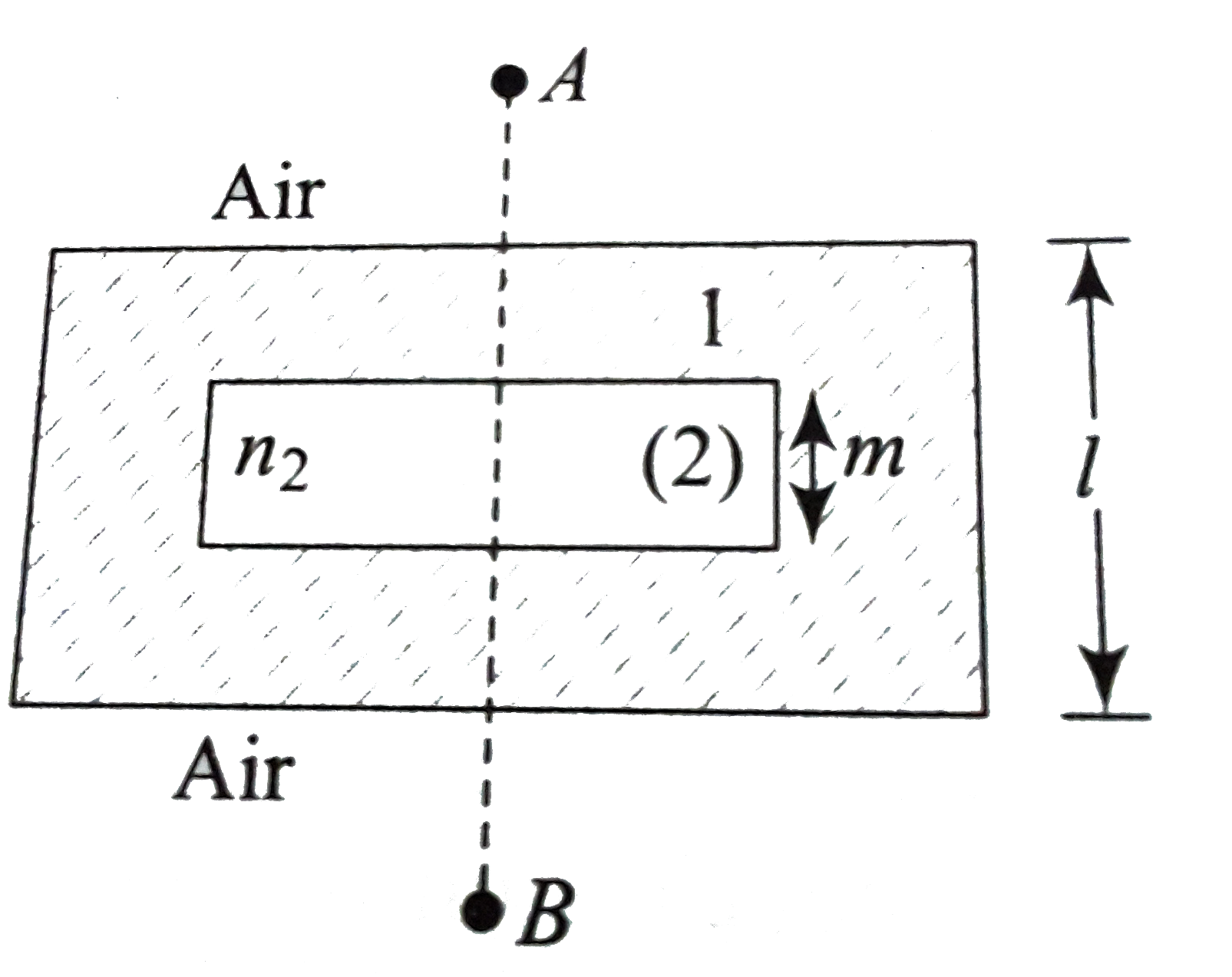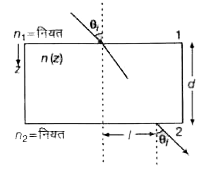A transparent slab of thickness d has a refractive index n(z) that increases with z. Here z is the vertical distance inside the slab, measured from the top. The slab is placed between two media with uniform refractive indices n1 and n2(>n1), θ0, from medium 1 and emerges in medium 2 with refraction angle θtwith a lateral displacement l.
Which of the following statement(s) is (are) true?

l is independent of n2
l is dependent on n(z)
n1sinθ2=n2sinθf
n1sinθ1=(n2−n1)sinθf
The correct Answer is:A, B, C
Step by step video, text & image solution for A transparent slab of thickness d has a refractive index n(z) that increases with z. Here z is the vertical distance inside the slab, measured from the top. The slab is placed between two media with uniform refractive indices n_(1) and n_(2)(gtn_(1)), theta_(0), from medium 1 and emerges in medium 2 with refraction angle theta_(t)with a lateral displacement l. Which of the following statement(s) is (are) true? by Physics experts to help you in doubts & scoring excellent marks in Class 12 exams.
Topper's Solved these Questions
Similar Questions
A fish looking up through the water sees the outside world contained in a circular horizon. If the refractive index of water is 43 and the fish is 12 cm below the surface, the radius of this circle is cm is
05:58View SolutionWater is filled in a container upto height 3m. A small hole of area 'a' is punched in the wall of the container at a height 52.5 cm from the bottom. The cross sectional area of the container is A. If a/A=0.1 then v2 is (where v is the velocity of water coming out of the hole)
03:36View SolutionSuppose the gravitational force varies inversely as the nth power of distance. Then the time period of a planet in circular orbit of radius 'R' around the sun will be proportional to
02:03View SolutionA transparent slab of thickness d has a refractive index n(z) that increases with z. Here z is the vertical distance inside the slab, measured from the top. The slab is placed between two media with uniform refractive indices n_(1) and n_(2)(gtn_(1)) , theta_(i) , from medium 1 and emerges in medium 2 with refraction angle theta_(f) with a lateral displacement l. Which of the following statement(s) is (are) true?
02:34View SolutionLet the x-z plane be the boundary between two transparent media. Medium 1 in zge0 has a refractive index of sqrt2 and medium 2 with zlt0 has a refractive index of sqrt3 . A ray of light in medium 1 given by the vector vecA=6sqrt3hati+8sqrt3hatj-10hatk is incident on the plane of separation. The angle of refraction in medium 2 is:
04:21View SolutionA ray of light passes through two slabs of same thickness. In the first slab n1 waves are formed and in the second slab n2. Find refractive <br> index of second medium with respect to first.
View SolutionIn a thick glass slab of thicknes l, and refractive index n1, a cuboidal cavity of thickness 'm' is carved as shown in figure, and is filled with a liquid of R.I.n2(n1>n2). The ratio l/m, so that shift produced by this slab is zero when an observer A observes an object B with paraxial rays is
 07:43View Solution
07:43View SolutionLet the x-z plane be the boundary between two transparent media. Media 1 in z≥0 has refractive index of √2 and medium 2 with z<0 has a refractive index of √3. A ray of light in medium 1 given by the vector →A=6√3ˆi+8√3ˆj−10ˆk in incident on the plane of separation. The angle of refraction in medium 2 is
View SolutionTwo concave mirrors each of focal length 'f' are placed infront of each other co=axially at a distance of 4d in a medium of refractive index n_(0) . A plane galss slab of refractive index 'n' & thickness 'd' is placed at a distance of 'd' from M_(1).A point object O is placed at a distace of 'd' from M_(2) as shown in the figure. Consider first reflection by M_(2) , then refraction on slab and then reflection by M_(1) . Determine the distance of this iamge after reflection from M_(1)
00:54View Solutiond मोटाई के एक पारदर्शी पट्ट के अपवर्तनांक n(z) का मान z बढ़ाने से बढ़ता है | यहाँ z पट्ट के अंदर ऊपरी सतह से मापी गयी ऊर्ध्वाधर दूरी है | पट्ट को दो n2(>n1) माध्यमों के बीच रखा गया है जिनके एकसमान अपवर्तनांक n1 एवं n2(>n1) है, जैसा कि चित्र में दर्शाया गया है | यहाँ n1 और n2 स्थिर हैं | प्रकाश की एक किरण माध्यम 1 से पट्ट पर, θi कोण से आपतित है तथा माध्यम 2 में पाश्विक विस्थापन l से अपवर्तन कोण, θf पर निकसित होती है |
 View Solution
View SolutionA ray is incident at a small angle θ on a glass slab of thickness t. If the refractive index of glass is μ , show that the lateral displacement of the emergent ray from the slab is t θ(μ−1)/μ.
View SolutionThe critical angle of a glass slab in air is 30^(@) . What will be the critical angle if the slab is placed in a medium of refractive index sqrt(2)
View SolutionA transparent slab of thickness d has a refractive index n(z) that increases with z. Here z is the vertical distance inside the slab, measured from the top. The slab is placed between two media with uniform refractive indices n_(1) and n_(2) (gtn_(1)) , as shown in the figure. A ray of light is incident with angle theta_(i) , from medium 1 and emerges in medium 2 with refraction and theta_(f) , with a lateral displacement l. Which of the following statement(s) is (are) true ?
01:13View SolutionA glass slab made of a material of refractive index n1 is kept in a medium of refractive index n2. A light ray is incident on the slab. Draw the path of the rays of light emerging from the glass slab, if (i) n1>n2 (ii) n1=n2 (iii) n1<n2.
05:25View SolutionA glass sla made of a material of refractive index n_(1) is kept in a medium of refractive index n_(2) . A light ray is incident on the slab. Complete the path of rays of light emerging from theglass slab, if : (i) n_(1)gtn_(2') (ii) n_(1)=n_(2)' (iii) n_(1)ltn_(2)
03:20View SolutionA ray of light passes through two slabs of same thickness. In the first slab n1 waves are formed and in the second slab n2. Find refractive <br> index of second medium with respect to first.
View Solution

